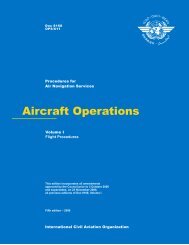Operation of Aircraft
Annex 6, Part I
Annex 6, Part I
- No tags were found...
Create successful ePaper yourself
Turn your PDF publications into a flip-book with our unique Google optimized e-Paper software.
Annex 6 — <strong>Operation</strong> <strong>of</strong> <strong>Aircraft</strong><br />
Approach and landing operations with vertical guidance.<br />
An instrument approach and landing which utilizes<br />
lateral and vertical guidance but does not meet the<br />
requirements established for precision approach and<br />
landing operations.<br />
Precision approach and landing operations. An instrument<br />
approach and landing using precision lateral and vertical<br />
guidance with minima as determined by the category <strong>of</strong><br />
operation.<br />
Note.— Lateral and vertical guidance refers to the guidance<br />
provided either by:<br />
a) a ground-based navigation aid; or<br />
b) computer generated navigation data.<br />
Categories <strong>of</strong> precision approach and landing operations:<br />
Category I (CAT I) operation. A precision instrument<br />
approach and landing with a decision height not lower<br />
than 60 m (200 ft) and with either a visibility not less<br />
than 800 m or a runway visual range not less than<br />
550 m.<br />
Category II (CAT II) operation. A precision instrument<br />
approach and landing with a decision height lower than<br />
60 m (200 ft), but not lower than 30 m (100 ft), and a<br />
runway visual range not less than 350 m.<br />
Category IIIA (CAT IIIA) operation. A precision instrument<br />
approach and landing with:<br />
a) a decision height lower than 30 m (100 ft) or no<br />
decision height; and<br />
b) a runway visual range not less than 200 m.<br />
Category IIIB (CAT IIIB) operation. A precision instrument<br />
approach and landing with:<br />
a) a decision height lower than 15 m (50 ft) or no<br />
decision height; and<br />
b) a runway visual range less than 200 m but not less<br />
than 50 m.<br />
Category IIIC (CAT IIIC) operation. A precision instrument<br />
approach and landing with no decision height and no<br />
runway visual range limitations.<br />
Note.— Where decision height (DH) and runway visual<br />
range (RVR) fall into different categories <strong>of</strong> operation, the<br />
instrument approach and landing operation would be conducted<br />
in accordance with the requirements <strong>of</strong> the most<br />
demanding category (e.g. an operation with a DH in the range<br />
<strong>of</strong> CAT IIIA but with an RVR in the range <strong>of</strong> CAT IIIB would<br />
be considered a CAT IIIB operation or an operation with a DH<br />
Part I<br />
in the range <strong>of</strong> CAT II but with an RVR in the range <strong>of</strong> CAT I<br />
would be considered a CAT II operation).<br />
Cabin crew member. A crew member who performs, in the<br />
interest <strong>of</strong> safety <strong>of</strong> passengers, duties assigned by the<br />
operator or the pilot-in-command <strong>of</strong> the aircraft, but who<br />
shall not act as a flight crew member.<br />
Commercial air transport operation. An aircraft operation<br />
involving the transport <strong>of</strong> passengers, cargo or mail for<br />
remuneration or hire.<br />
Configuration deviation list (CDL). A list established by the<br />
organization responsible for the type design with the<br />
approval <strong>of</strong> the State <strong>of</strong> Design which identifies any<br />
external parts <strong>of</strong> an aircraft type which may be missing at<br />
the commencement <strong>of</strong> a flight, and which contains, where<br />
necessary, any information on associated operating limitations<br />
and performance correction.<br />
Crew member. A person assigned by an operator to duty on an<br />
aircraft during a flight duty period.<br />
Cruise relief pilot. A flight crew member who is assigned to<br />
perform pilot tasks during cruise flight, to allow the pilotin-command<br />
or a co-pilot to obtain planned rest.<br />
Cruising level. A level maintained during a significant portion<br />
<strong>of</strong> a flight.<br />
Dangerous goods. Articles or substances which are capable <strong>of</strong><br />
posing a risk to health, safety, property or the environment<br />
and which are shown in the list <strong>of</strong> dangerous goods in the<br />
Technical Instructions or which are classified according to<br />
those Instructions.<br />
Note.— Dangerous goods are classified in Annex 18,<br />
Chapter 3.<br />
Decision altitude (DA) or decision height (DH). A specified<br />
altitude or height in the precision approach or approach<br />
with vertical guidance at which a missed approach must be<br />
initiated if the required visual reference to continue the<br />
approach has not been established.<br />
Note 1.— Decision altitude (DA) is referenced to mean sea<br />
level and decision height (DH) is referenced to the threshold<br />
elevation.<br />
Note 2.— The required visual reference means that section<br />
<strong>of</strong> the visual aids or <strong>of</strong> the approach area which should have<br />
been in view for sufficient time for the pilot to have made an<br />
assessment <strong>of</strong> the aircraft position and rate <strong>of</strong> change <strong>of</strong><br />
position, in relation to the desired flight path. In Category III<br />
operations with a decision height the required visual reference<br />
is that specified for the particular procedure and operation.<br />
Note 3.— For convenience where both expressions are used<br />
they may be written in the form “decision altitude/ height” and<br />
abbreviated “DA/H”.<br />
1/11/01 23/11/06<br />
1-2<br />
No. 30












